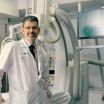(Press-News.org) The global economy depends on marine transportation. But in addition to cargo, the world's 50,000-plus commercial ships carry tiny stowaways that can cause huge problems for the environment and economy. A new model created by Smithsonian scientists will facilitate accurate screening of vessels for dangerous species before they unload. The team's findings are published today in the journal Environmental Science & Technology.
Ballast water taken up by ships in coastal waters teems with plankton and microbes. When discharged at the next port of call, these hitchhikers can wreak havoc on receiving ecosystems. Under current federal regulations, ships exchange their ballast water in the open ocean to flush out unwanted species. However, some survive the process, and not all ships travel across oceans. Environmental regulators have known about this problem for decades. But while regulators check ship records and can sometimes test salinity to verify compliance, unlike many pollutants, there are no federal requirements limiting the number of viable, potentially dangerous organisms.
That is about to change. The U.S. Coast Guard has proposed a new set of rules limiting the number of organisms allowed, in line with current International Maritime Organization standards. For larger zooplankton (length, width or height at least 50 microns, or one-half the thickness of a piece of paper), the number must be fewer than 10 viable organisms per cubic meter (264 gallons). On-board ballast water treatment technologies offer a promising solution, enabling ships to substantially cut the risk of delivering dangerous species. But while a few systems have entered the market, the challenge of testing the ballast water—and the technology—remains. A major stumbling block is simply understanding how such testing should occur and how much ballast water must be tested in order to count very sparse numbers of organisms.
To help regulators and engineers develop and test such treatment systems, and ultimately enforce these standards, a team of researchers developed a statistical model to see how to count small, scarce organisms in large volumes of water accurately. Led by Whitman Miller, research ecologist at the Smithsonian Environmental Research Center, the scientists took samples that exceeded the limit and ran them through various tests to see which violations would be spotted. Larger samples gave the best results: sampling only 0.1 cubic meter of water (26.4 gallons) made it difficult to detect concentrations even twice as high as the standard. By contrast, when they raised the volume to 7 cubic meters (1848 gallons), the test regularly picked up violations as low as 13 zooplankton per cubic meter.
Another innovation of the model is that it can pool sample results over time and possibly across ships, making it easier to determine if treatment systems function as advertised and thus whether ships are actually compliant or not. Since analyzing samples larger than 7 cubic meters is difficult for most cargo ships, by taking multiple 7-cubic-meter samples, regulators could effectively raise the volume without overburdening the ships.
"When trying to decide how to evaluate a treatment system, we need to balance scientific rigor with what is logistically feasible," said Miller. "Science can help inform regulatory efforts. However, in the end, it is necessary for regulators to determine the level of environmental protection that is acceptable in accordance with both scientific evidence and the needs and desires of society."
"The findings of this study will greatly assist the Coast Guard to develop and implement effective and economical procedures for approving treatment equipment and verifying compliance by ships in meeting discharge standards to minimize the risk of introducing potentially harmful organisms to U.S. aquatic ecosystems," said Richard Everett, an environmental scientist with the Coast Guard's Environmental Standards Division.
The Coast Guard proposal would require most ships arriving in U.S. waters to have ballast water-treatment systems that dramatically reduce the number of living organisms in their discharge. Under the proposed regulation, most existing ships would have until 2014 or 2016 to comply, but any ships built after Jan. 1, 2012, would need to comply immediately. The agency estimated in 2009 that the new regulation could cost as much as $168 million a year, largely for ships to install the new technologies necessary to comply. However, in terms of economic and environmental damage avoided, it could save anywhere from $165 to $585 million a year.
The Coast Guard is also considering implementing a second phase of regulations, which would be up to a thousand times more stringent than the International Maritime Organization standards, perhaps beginning in 2016, but subject to an assessment of practicability.
INFORMATION:
The article is available here: http://pubs.acs.org/doi/pdf/10.1021/es102790d
Images should be credited to the Maritime Environmental Resource Center.
Smithsonian scientists help block ship-borne bioinvaders before they dock
New strategy helps ships screen for unwanted passengers
2011-03-29
ELSE PRESS RELEASES FROM THIS DATE:
Interventional radiology treatment takes blood pressure to new lows -- and results last
2011-03-29
CHICAGO, Ill. (March 28, 2011)—Interventional radiologists have completed the first human randomized controlled trial of therapeutic renal denervation or RDN—a procedure that uses a catheter-based probe inserted into the renal artery that emits high-frequency energy to deactivate the nerves near the kidneys (or in the renal artery) that are linked to high blood pressure. The researchers say these results confirm that RDN may be an effective therapy for reducing—and consistently controlling—resistant hypertension when current medications have failed. The results were presented ...
Interventional radiologists advance MS research: Vein-opening treatment safe
2011-03-29
CHICAGO, Ill. (March 28, 2011)—Understanding that angioplasty—a medical treatment used by interventional radiologists to widen the veins in the neck and chest to improve blood flow—is safe may encourage additional studies for its use as a treatment option for individuals with multiple sclerosis, say researchers at the Society of Interventional Radiology's 36th Annual Scientific Meeting in Chicago, Ill.
"Angioplasty—the nonsurgical procedure of threading a thin tube into a vein or artery to open blocked or narrowed blood vessels—is a safe treatment. Our study will provide ...
Interventional radiologists take lead on reducing disability from dangerous blood clots
2011-03-29
CHICAGO, Ill. (March 28, 2011)—Deep vein thrombosis, or DVT: it's more than just a one-time complication from taking a long plane ride. The Society of Interventional Radiology wants individuals to know the risk factors for this very serious condition, which can lead to post-thrombotic syndrome, pulmonary embolism, permanent damage to the leg and even death.
"Individuals and their doctors need to be aware that in the United States alone about 600,000 people are hospitalized with deep vein thrombosis each year and more than 100,000 people die of resulting pulmonary embolism," ...
Interventional Radiology Y-90 Liver Cancer-busting Treatment: Safe, Fast, Extends Life
2011-03-29
Interventional radiologists have been the leaders in the use of intra-arterial yttrium-90 radioembolization, since its introduction in 2000, to treat liver cancer. Now, new results from a large multi-institutional study show that treating liver tumors with higher doses of Y-90 than previously tried is safe, provides results when chemotherapies have failed, preserves the patient's quality of life—and can be done on an outpatient basis. This study, presented by researchers at the Society of Interventional Radiology's 36th Annual Scientific Meeting in Chicago, Ill., further ...
Some ingredients in 'green' products come from petroleum rather than natural sources
2011-03-29
Contact: Michael Bernstein
m_bernstein@acs.org
714-765-2012 (Meeting, March 27-31)
202-872-6042 (Before March 27)
Michael Woods
m_woods@acs.org
714-765-2012 (Meeting, March 27-31)
202-872-6293 (Before March 27)
American Chemical Society
Some ingredients in 'green' products come from petroleum rather than natural sources
ANAHEIM, March 28 , 2011 — With more and more environmentally conscious consumers choosing "green" products, scientists today reported that the first reality check has revealed that the ingredients in those products may ...
From crankcase to gas tank: New microwave method converts used motor oil into fuel
2011-03-29
Contact: Michael Bernstein
m_bernstein@acs.org
714-765-2012 (Meeting, March 27-31)
202-872-6042 (Before March 27)
Michael Woods
m_woods@acs.org
714-765-2012 (Meeting, March 27-31)
202-872-6293 (Before March 27)
American Chemical Society
From crankcase to gas tank: New microwave method converts used motor oil into fuel
This release is also available in Chinese on EurekAlert! Chinese.
ANAHEIM, March 28, 2011 — That dirty motor oil that comes out of your car or truck engine during oil changes could end up in your fuel tank, according to a report ...
Potential new medicines show promise for treating colon cancer, asthma
2011-03-29
Contact: Michael Bernstein
m_bernstein@acs.org
714-765-2012 (Meeting, March 27-31)
202-872-6042 (Before March 27)
Michael Woods
m_woods@acs.org
714-765-2012 (Meeting, March 27-31)
202-872-6293 (Before March 27)
American Chemical Society
Potential new medicines show promise for treating colon cancer, asthma
ANAHEIM, March 28, 2011 — In what they described as the opening of a new era in the development of potentially life-saving new drugs, scientists today reported discovery of a way to tone down an overactive gene involved in colon cancer and ...
Mimicking Mother Nature yields promising materials for drug delivery and other applications
2011-03-29
Contact: Michael Bernstein
m_bernstein@acs.org
714-765-2012 (Meeting, March 27-31)
202-872-6042 (Before March 27)
Michael Woods
m_woods@acs.org
714-765-2012 (Meeting, March 27-31)
202-872-6293 (Before March 27)
American Chemical Society
Mimicking Mother Nature yields promising materials for drug delivery and other applications
ANAHEIM, March 28, 2011 — Mimicking Mother Nature's genius as a designer is one of the most promising approaches for developing new medicines, sustainable sources of food and energy, and other products that society needs ...
Commentary: When creating a new institute, the devil's in the details
2011-03-29
When the recent decision was made to merge the National Institute on Alcohol Abuse and Alcoholism (NIAAA) and the National Institute on Drug Abuse (NIDA) into a yet unnamed institution, there were a lot of questions as to how, and even why, it needed to be done. A commentary piece to be released in the April 2011 issue of Alcoholism: Clinical & Experimental Research, which is currently available at Early View, explores that subject in great detail to analyze its problems and present possible solutions.
One of the main issues, according to leading alcohol researchers who ...
SU physicists first to observe rare particles produced at the Large Hadron Collider at CERN
2011-03-29
Shortly after experiments on the Large Hadron Collider (LHC) at the CERN laboratory near Geneva, Switzerland began yielding scientific data last fall, a group of scientists led by a Syracuse University physicist became the first to observe the decays of a rare particle that was present right after the Big Bang. By studying this particle, scientists hope to solve the mystery of why the universe evolved with more matter than antimatter.
Led by Sheldon Stone, a physicist in SU's College of Arts and Sciences, the scientists observed the decay of a special type of B meson, ...
LAST 30 PRESS RELEASES:
Missed signals: Virginia’s septic strategies overlook critical timing, study warns
Delayed toxicities after CAR T cell therapy for multiple myeloma are connected and potentially preventable
Scientists find cellular key to helping plants survive in saltwater
Medical cannabis program reduces opioid use
Immunotherapy works for sepsis thanks to smart patient selection
Cardiovascular events 1 year after RSV infection in adults
US medical prices and health insurance premiums, 1999-2024
Medical cannabis and opioid receipt among adults with chronic pain
Multichannel 3D-printed bioactive scaffold combined with siRNA delivery for spinal cord injury recovery
Triaptosis—an emerging paradigm in cancer therapeutics
A new paradigm in spectroscopic sensing: The revolutionary leap of SERS-optical waveguide integration and ai-enabled ultra-sensitive detection
Sweet tooth: How blood sugar migration in diabetes affects cavity development
Lowest suicide rate is in December but some in media still promote holiday-suicide myth
Record-breaking cosmic explosion challenges astronomers’ understanding of gamma-ray bursts
Excessive heat harms young children’s development, study suggests
Quanta Books to publish popular math and physics titles by Terence Tao and David Tong
Philanthropic partnerships fund next-generation instruments for mid-sized telescopes
AI offers ‘roadmap’ to plant genetics
Myosin XI-1: A key molecular target for salt-tolerant crops
Pusan National University study highlights the health hazards of ultrafine particles from small home appliances with electric heating coils and brushed DC motors
Global first: New Indigenous-led research initiative to revitalize legal orders
Transforming acoustic waves with a chip
When climate risk hits home, people listen: Study reveals key to engagement with disaster preparedness messaging
Major breakthrough against diabetes thanks to a microbial molecule that disarms inflammation
Silicon chips on the brain: Researchers announce a new generation of brain-computer interface
Getting rest is the best
Towards sustainable organic synthesis – Mechanochemistry replaces lithium with sodium in organic reactions
Wireless device ‘speaks’ to the brain with light
Greenhouse gases to intensify extreme flooding in the Central Himalayas
New study sheds light on Milky Way's mysterious chemical history
[Press-News.org] Smithsonian scientists help block ship-borne bioinvaders before they dockNew strategy helps ships screen for unwanted passengers




